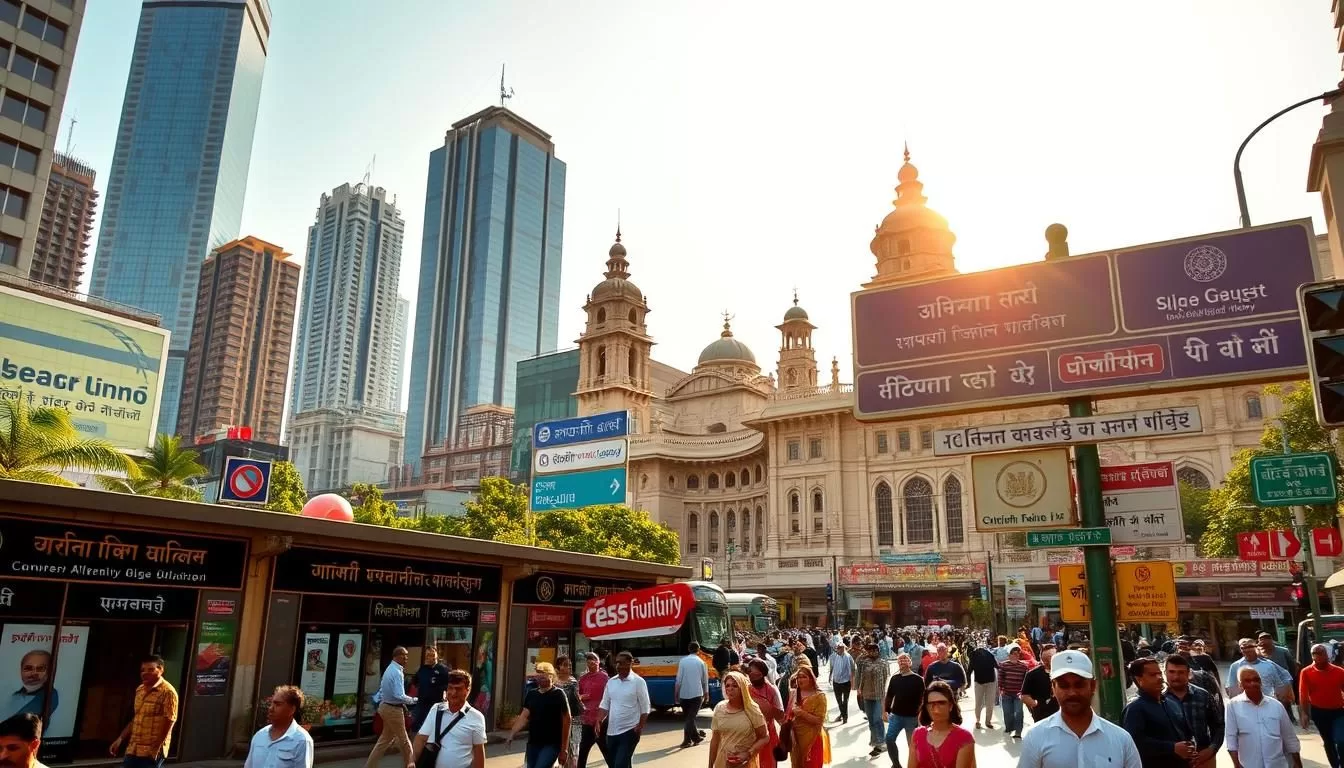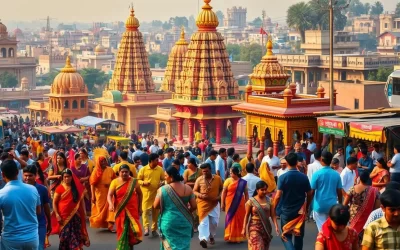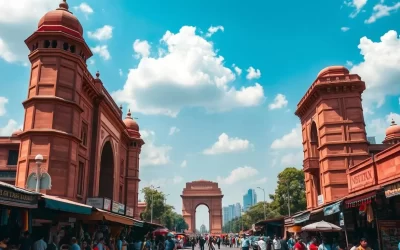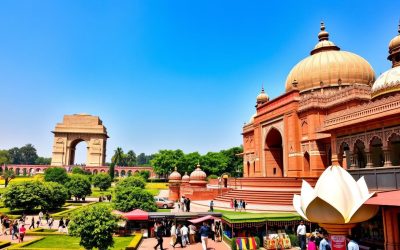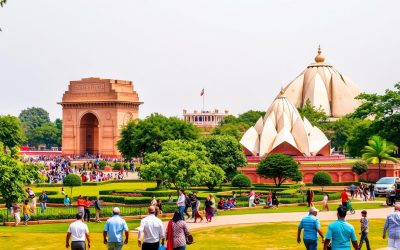You are about to explore the rich tapestry of languages spoken in the heart of India‘s vibrant National Capital Territory.
Hindi is the official language of the region, while English serves as a co-official language, playing a crucial role in governance and daily life.
The language landscape here is complex, shaped by historical, cultural, and migratory factors. As you delve into this guide, you’ll understand how languages like Hindi and English coexist with other languages, reflecting the broader multilingual character of India.
This exploration will not only introduce you to the official language and other languages but also provide insights into the constitutional framework that governs language policies in the National Capital Territory.
The Linguistic Landscape of National Capital Territory
The linguistic landscape of Delhi is a fascinating reflection of India’s cultural mosaic, with numerous languages coexisting in harmony. As you explore the city’s linguistic diversity, you’ll discover a complex tapestry of language use that reflects the city’s history, culture, and demographics.
Geographic and Demographic Context
Delhi, being the capital city of India, attracts people from various parts of the country, contributing to its linguistic diversity. According to the 1991 census, a significant number of languages are spoken in India, with 22 having more than a million native speakers. The city’s demographic profile is characterized by a mix of native Delhiites and migrants from different states, each bringing their own language.
Language Diversity in Delhi
Delhi’s linguistic diversity is marked by the presence of various languages spoken in the city, including Indo-Aryan, Dravidian, and Tibeto-Burman languages. The city’s language profile is dominated by Indo-Aryan languages, but there’s also a significant presence of Dravidian languages like Tamil, Telugu, and Malayalam. You can observe how language use varies across different contexts in Delhi, from formal government settings to marketplaces and homes.
The data from the 1991 census highlights that 50 languages have more than 100,000 native speakers, and 114 languages have more than 10,000 native speakers in India. This linguistic diversity is a reflection of the country’s rich cultural heritage, with languages spoken India being an integral part of its identity. As you delve deeper, you’ll find that the language dynamics in Delhi are shaped by the city’s history, migration patterns, and cultural exchange.
National Capital Territory, India: Official and widely spoken languages
The National Capital Territory of India is a melting pot of languages, with Hindi and English playing crucial roles. As the capital region, it hosts a diverse population, making language a vital aspect of its cultural identity.
Hindi as the Primary Official Language
Hindi is recognized as the primary official language of the National Capital Territory. This status was reinforced by the Official Languages Act of 1963, which aimed to promote Hindi as the official language of the Union. Despite initial resistance from non-Hindi speaking areas, Hindi has become integral to government functions and daily life. The government has promoted Hindi through various initiatives, enhancing its status as a unifying language across the nation.
The history of Hindi as an official language is complex, with roots tracing back to the independence movement. Today, it serves as a lingua franca, facilitating communication among people from different linguistic backgrounds.
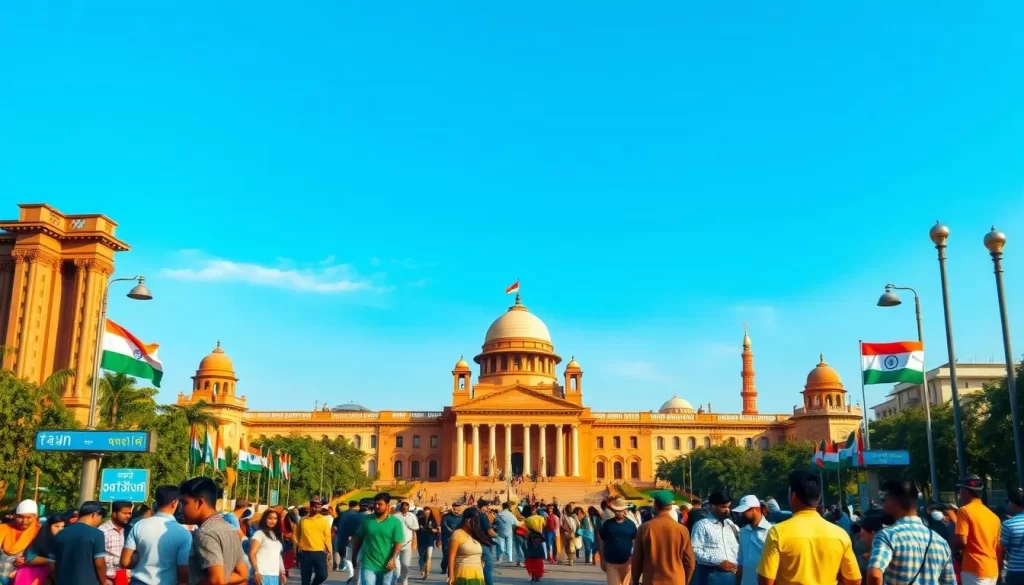
English as the Co-Official Language
English continues to play a significant role as a co-official language in the National Capital Territory. The Official Languages Act of 1963 ensured that English would remain in use for official purposes alongside Hindi, even after 1965. This decision was crucial for maintaining administrative continuity and facilitating international communication.
In the National Capital Territory, English is widely used in administration, higher education, and the business sector. It is considered a language of prestige and opportunity, often serving as a marker of education and socioeconomic status. The use of English is particularly prevalent in Delhi’s technology industry and higher education institutions, where it is the primary language for instruction and professional communication.
The coexistence of Hindi and English in the National Capital Territory reflects the region’s linguistic diversity. Code-switching between these two languages is common, illustrating the complex relationship between language, culture, and identity in this vibrant urban landscape.
The Constitutional Status of Languages in India
Understanding the constitutional status of languages in India is essential for grasping the complexities of its linguistic landscape. The Indian Constitution has provisions that directly impact the country’s language policy.
Article 343 and Language Policy
Article 343 of the Indian Constitution declares Hindi as the official language of the country. However, it also makes provisions for the continued use of English for official purposes. This article is crucial in understanding India’s language policy, as it strikes a balance between promoting Hindi and accommodating other languages.
The Constitution empowers the government to formulate policies that promote the development and propagation of Hindi, while also ensuring that other languages are not neglected. This has led to a complex linguistic ecosystem where multiple languages coexist.
The Eighth Schedule Languages
The Eighth Schedule of the Indian Constitution recognizes 22 official languages, providing them with special status and support. These languages are considered significant for the cultural and linguistic heritage of the country. The inclusion of a language in this schedule has implications for its development, preservation, and promotion.
| Language | Status | Significance |
|---|---|---|
| Hindi | Official Language | Primary language for government administration |
| English | Co-Official Language | Used for official purposes alongside Hindi |
| Eighth Schedule Languages | Recognized Languages | Supported for cultural and linguistic heritage |
![]()
The Eighth Schedule has undergone amendments to include more languages, reflecting the government‘s efforts to be more inclusive of the diverse linguistic population. As a result, states are free to decide their own language for internal administration and education, leading to a rich tapestry of languages across different regions.
Indo-Aryan Languages in Delhi
Indo-Aryan languages are an integral part of Delhi’s identity, reflecting the city’s complex history and cultural heritage. The prevalence of these languages is a testament to the city’s rich linguistic diversity.
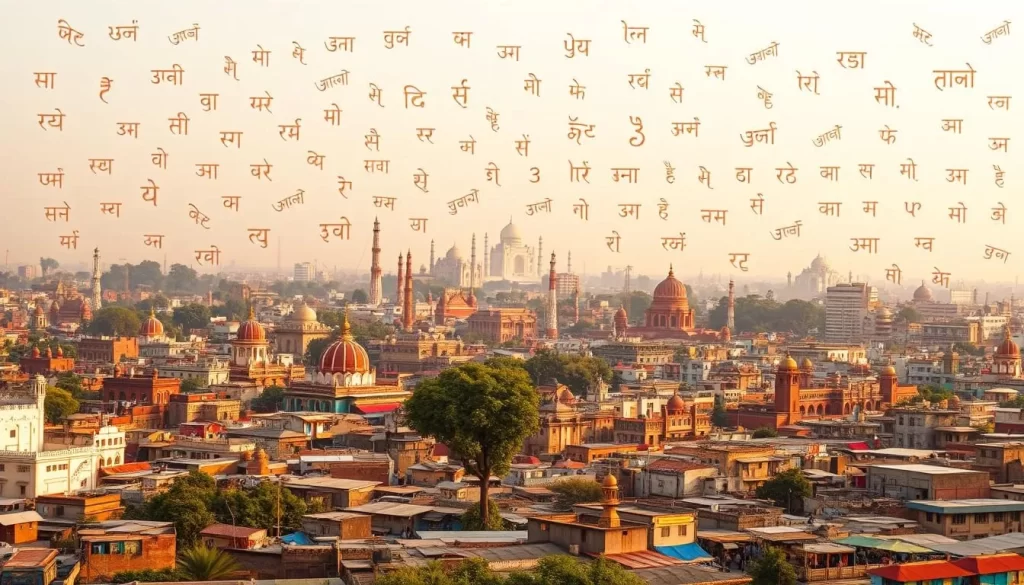
Hindi and Its Dialects
Hindi is a prominent language in Delhi, serving as the primary official language. It has various dialects that are spoken across different regions of the city. The modern form of Hindi emerged in the 19th century, deriving its vocabulary and script (Devanagari) mainly from Sanskrit. This linguistic evolution has contributed significantly to Delhi’s cultural identity.
The dialects of Hindi spoken in Delhi reflect the city’s cultural and geographical diversity. These dialects are an essential part of the city’s linguistic landscape, showcasing the complex interplay between language and culture.
Urdu and Its Cultural Significance
Urdu, another significant language in Delhi, has a rich cultural heritage. Although grammatically identical to Hindi, Urdu draws much of its vocabulary from Persian and Arabic and is written in the Perso-Arabic script. This distinction in vocabulary and script has contributed to Urdu’s unique cultural significance in the city.
Delhi has been a major center of Urdu literature and culture for centuries. The city’s famous Urdu poets, writers, and cultural figures have enriched its literary heritage. Urdu continues to thrive in specific neighborhoods, particularly in Old Delhi and areas with significant Muslim populations, serving as an important marker of cultural identity and historical continuity.
Dravidian and Other Language Families in Delhi
You might be surprised to know that Delhi’s linguistic landscape is enriched by languages from various families, including Dravidian. As people from different parts of India migrate to Delhi for education, employment, or refuge, they bring their languages with them, contributing to the city’s linguistic diversity.
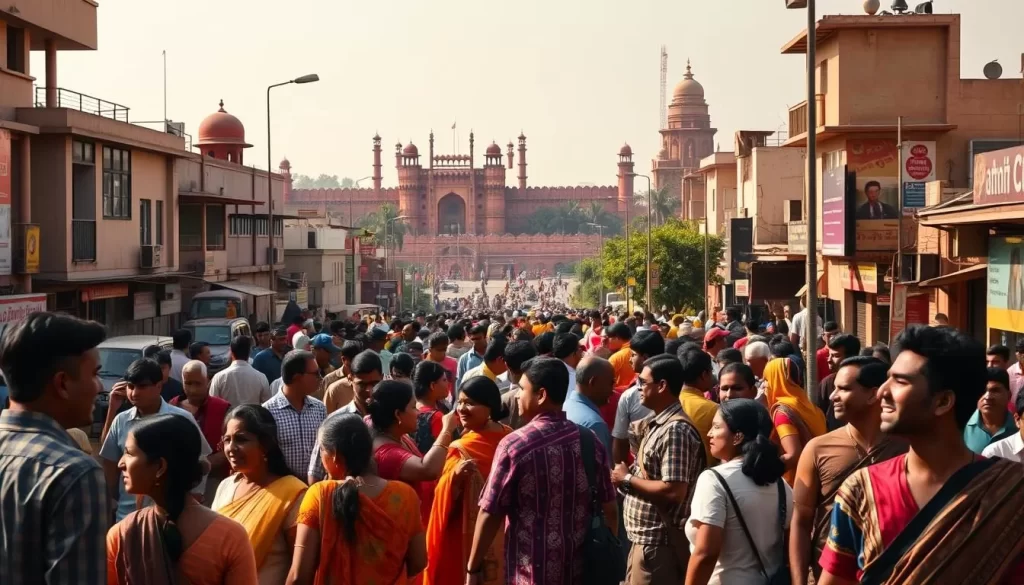
Tamil, Telugu, Malayalam and Kannada Speakers
Delhi is home to a significant number of speakers of Dravidian languages such as Tamil, Telugu, Malayalam, and Kannada. These languages are predominantly spoken by people from South India who have migrated to the capital. Tamil and Telugu speakers form a considerable portion of this demographic, with many being employed in the IT sector or other professional fields. The presence of these language speakers adds to the linguistic richness of Delhi, making it a culturally vibrant city.
Community organizations and cultural associations play a crucial role in maintaining the linguistic heritage of these communities. They organize cultural events, language classes, and other activities that help in preserving their languages and cultural traditions.
Tribal and Minority Languages
Apart from the major Dravidian languages, Delhi is also home to speakers of tribal and minority languages. Although many tribal communities are gradually abandoning their tribal languages, scores of such languages survive. For instance, languages like Santhali, belonging to the Munda branch of the Austroasiatic family, are spoken by a significant number of people. Community organizations and cultural associations are vital in supporting the maintenance of these minority languages in Delhi.
These smaller language communities contribute significantly to Delhi’s overall linguistic diversity and cultural richness. Their presence is a testament to the city’s ability to accommodate and integrate diverse linguistic and cultural groups.
Writing Systems and Scripts
As you navigate through Delhi, you’ll notice the multitude of scripts that adorn the city’s streets, from government offices to commercial establishments. This diversity reflects the city’s status as a cultural melting pot.
Devanagari Script
The Devanagari script is one of the most widely used scripts in Delhi, primarily for writing Hindi and other languages like Sanskrit and Marathi. It’s an abugida, a type of script where consonants have inherent vowels. You can see Devanagari in use across various contexts, from street signs to literature.
Perso-Arabic Script for Urdu
The Perso-Arabic script is used for writing Urdu, a language with significant cultural and literary status in Delhi. This script is adapted from Arabic and is written from right to left. You’ll find it used in various cultural and literary contexts, reflecting the city’s rich linguistic diversity.
Other Scripts in Use
Beyond Devanagari and Perso-Arabic, Delhi’s linguistic landscape includes a variety of other scripts. For instance, the Gurmukhi script is used by Punjabi speakers, while the Bengali script is used by Bengali communities, hailing from West Bengal. You can observe these scripts in community-specific areas and multilingual signage in government offices and commercial establishments.
Language in Education and Administration
Understanding the languages used in Delhi’s schools and government offices is essential for grasping the city’s administrative and educational framework. You will discover how languages are utilized in various contexts, from educational institutions to government services.
Medium of Instruction in Delhi Schools
Delhi’s educational system is characterized by a diverse range of languages used as the medium of instruction. Hindi and English are the primary languages used in schools. The choice of medium of instruction can significantly impact a student’s academic performance and future opportunities.
| Language | Number of Schools | Percentage of Students |
|---|---|---|
| Hindi | 60% | 55% |
| English | 30% | 40% |
| Other Languages | 10% | 5% |
Languages in Government Services
In government services, Hindi and English serve as the primary official languages, as mandated by the government of India. You will find that government offices, public services, and official documents often use these languages to cater to the diverse population.
The use of multiple languages in government services helps accommodate Delhi’s linguistically diverse population. For instance, public announcements, government forms, and official websites are often available in both Hindi and English.
Language Contact and Linguistic Evolution
Language contact has played a pivotal role in shaping the linguistic evolution of Delhi. Over three millennia, the convergence of four language families in India has resulted in a complex linguistic landscape. This contact has given rise to significant linguistic changes and adaptations.
Hindustani as a Lingua Franca
Hindustani, a blend of Hindi and Urdu, has emerged as a common language for communication among people from different linguistic backgrounds in Delhi. It serves as a lingua franca, facilitating interaction in markets, government services, and educational institutions. The widespread use of Hindustani is a testament to the city’s history of language contact and its role in fostering unity amidst diversity.
The influence of Sanskrit, Persian, and English on Hindustani is evident in its vocabulary and syntax. For instance, many words borrowed from Persian are used in everyday conversation, while English loanwords are common in modern contexts.
Influence of Migration on Delhi’s Languages
Migration has been a significant factor in shaping Delhi’s linguistic landscape. Waves of migration from various parts of India have continuously reshaped the city’s language profile. For example, the influx of Punjabi speakers after Partition significantly altered the linguistic demographics.
| Language Family | Speakers | District |
|---|---|---|
| Indo-Aryan | Hindi, Punjabi | North Delhi |
| Dravidian | Tamil, Telugu | South Delhi |
The formation of linguistic enclaves in different parts of Delhi has allowed communities to maintain their languages while adapting to the broader linguistic environment. This has resulted in a dynamic linguistic ecology, with ongoing migration continuing to transform the city’s language landscape.
Conclusion: The Future of Linguistic Diversity in Delhi
The National Capital Territory of India is at a crossroads, where the path chosen will determine the fate of its rich linguistic heritage. As you explore the future prospects for linguistic diversity in Delhi, it becomes clear that the city is navigating a complex interplay of forces. On one hand, linguistic homogenization is driven by the increasing use of English and Hindustani as lingua francas, facilitated by globalization and technological advancements. On the other hand, there are robust efforts to preserve and promote the diverse languages of India, including initiatives by the central government and community-based programs.
Delhi’s experience in managing linguistic diversity offers valuable lessons for other multilingual urban centers worldwide. The city’s linguistic landscape is influenced by factors such as education, media, and migration patterns. For instance, the role of Dravidian languages and other regional languages continues to be significant, reflecting the cultural identities of communities from Himachal Pradesh, Uttar Pradesh, and West Bengal. As Delhi evolves, understanding the dynamics between these factors will be crucial for maintaining its linguistic diversity.
You will see that the future of linguistic diversity in Delhi is shaped by both challenges and opportunities. By embracing its multilingual identity and fostering an environment that supports diverse Indian languages, Delhi can continue to thrive as a vibrant cultural and linguistic hub within the National Capital Territory. This approach not only enriches the city’s social fabric but also contributes to the nation’s cultural heritage.
The above is subject to change.
Check back often to TRAVEL.COM for the latest travel tips and deals.
